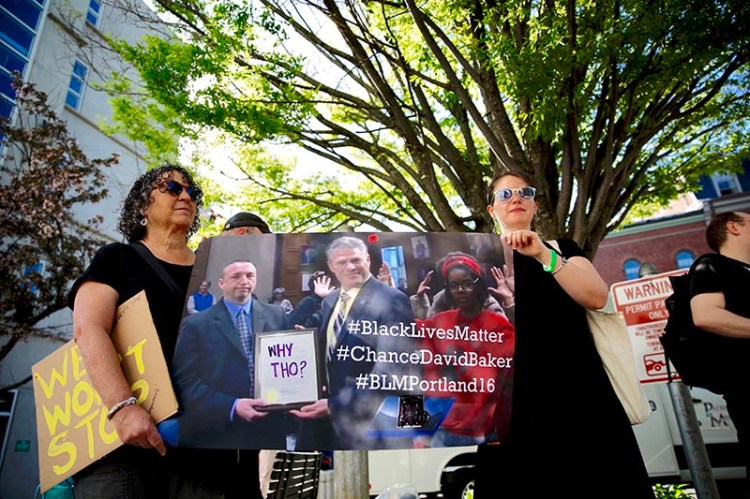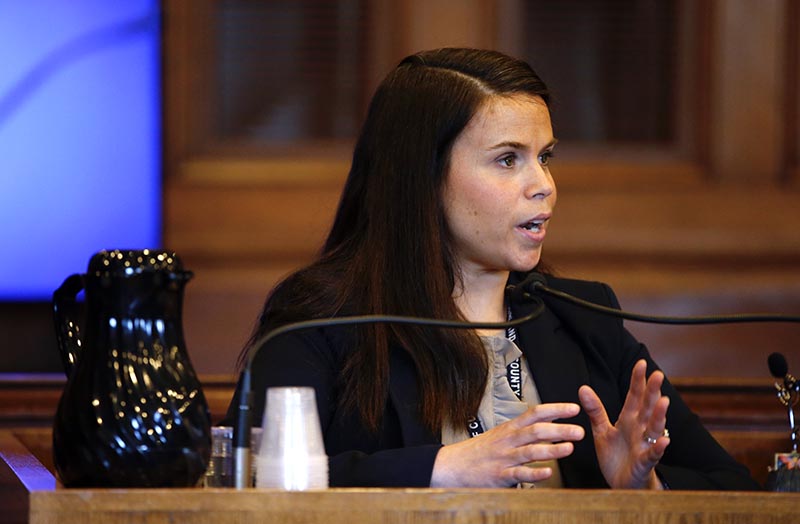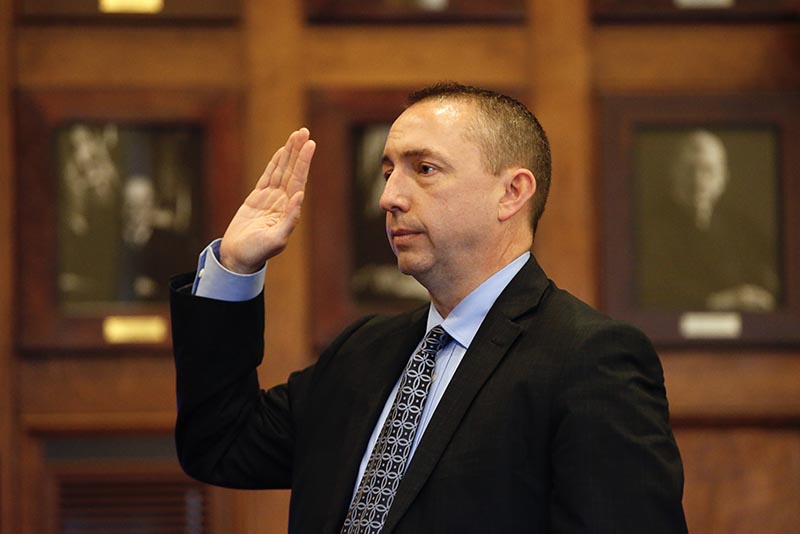After an all-day hearing Friday, a judge in Cumberland County Superior Court said he will rule next week on whether 17 Black Lives Matter protesters who were arrested after a march in Portland last summer fulfilled the terms of a plea agreement or should be tried on criminal charges.
The protesters pleaded guilty in January to civil charges of violating a city ordinance on disorderly conduct, paid $200 fines and agreed to take part in a “restorative justice” meeting with police to discuss their July protest march, during which they blocked part of Commercial Street for hours on a busy Friday night. They were protesting nationwide police killings of black men.
But the Cumberland County district attorney said they failed to live up to the plea agreement when a meeting with police fell apart on Feb. 1 over a disagreement on whether the protesters could meet with Portland Police Chief Michael Sauschuck in one group or two, and whether the deputy district attorney and others could take part in the session.
That moved the case back to court, with the District Attorney’s Office trying to persuade Justice Lance Walker to rule that the protesters violated the terms of the plea agreement and order them tried on the original criminal charges, which are more serious than the ordinance violation to which they pleaded guilty. Most would be charged with obstructing public ways and failure to disperse, but some would face disorderly conduct and other, more serious criminal charges.
Friday’s hearing lasted seven hours, highlighted by the unusual sight of lawyers taking the oath and being examined and cross-examined by other lawyers. The only non-lawyers to testify were Sauschuck and one of the protesters.
The case largely hinges on two words: “as directed.”
In the plea agreement, the protesters agreed to take part in the restorative justice meeting “as directed” by the District Attorney’s Office. Defense lawyers said they took that phrase to suggest the prosecutors would set up a time and a place with a Portland organization that tries to foster reconciliation between criminals and crime victims.
But the District Attorney’s Office interpreted the two words much more broadly, saying it meant that the protesters would show up when and where the office arranged, agree to meet with Sauschuck in two groups and allow Deputy District Attorney Jennifer Ackerman and two “community observers” to take part in the session.
“We thought it was a good idea to have people there to witness it,” Ackerman said, explaining the outside observers.
As for splitting the group in two, she said, “we really wanted it to be a meaningful discussion and I thought that 17 was really a lot.”
On the other hand, the protesters’ lawyers said that allowing their clients to meet with a prosecutor without a lawyer present would violate their rights.
John Gale said that if his client was going to attend a meeting with the District Attorney’s Office, he would want to sit in.
“Lawyers don’t want to be part of this thing,” he said. “We’ll only mess it up.” Several of the defendants’ lawyers said they never would have advised their clients to take the plea deal if they had known how broadly “as directed” was going to be applied, and said the District Attorney’s Office was trying to give itself overly wide discretion to interpret whether the protesters held up their end of the arrangement.
Although Walker didn’t indicate how he might rule, an observation he made near the end of the hearing suggested he might be inclined to agree.
He said the courts have ruled that plea agreements can be treated as contracts. And, he said, courts have ruled that when a contract is ambiguous, disputed interpretations should be decided against the party that drafted the contract, under the theory that the drafting party has a special obligation to avoid uncertainty and shouldn’t profit from unclear language.
The plea agreement was drafted by Ackerman, including the “as directed” language.
Several witnesses also went into great detail about how the Feb. 1 meeting went awry, and most of the protesters’ lawyers pointed the finger at District Attorney Stephanie Anderson.
They said the defendants’ lawyers and Ackerman were trying to work out a deal to allow the session to go forward. For instance, they said, they suggested that Ackerman could take part as long as the group could stay together, although in her testimony, Ackerman said that she hadn’t agreed to those terms.
Alba Briggs, one of the protesters, said the group wanted to stay together for solidarity and because the division proposed by the District Attorney’s Office, although done alphabetically, happened to break along largely racial lines.
But Amanda Doherty, an assistant district attorney, complained that the protesters were trying to control the meeting the same way that they took control of a major intersection on Commercial Street during their protest last summer.
“They were demanding that they still be in charge of the process,” she said.
Anderson said she got involved when she learned by text message from Ackerman that the protesters at the meeting “threw out” Rachel Talbot Ross, who was representing the Portland chapter of the NAACP – although the protesters insisted that they merely pointed out they hadn’t invited her to the meeting and she opted to leave on her own.
Anderson said that when she got the text, she went to the meeting and, within a few minutes, concluded that it wasn’t going anywhere. Then she, Ackerman and Sauschuck left.
“I said, ‘They have to have a better attitude,’ ” she said, concluding that wasn’t going to happen on the day of the meeting.
“I just said, ‘We’re leaving,’ ” Anderson said, and her office soon decided to seek to have the charges refiled.
But the defendants’ lawyers said the judge shouldn’t find that their clients didn’t fulfill the plea deal when it was the prosecutors who walked out of the meeting.
Anderson said her office mostly relied on the group that runs the Restorative Justice program to structure the meeting.
“We really didn’t know what we were doing,” she said, because the program is usually intended to help individual crime victims and criminals come to terms on what constitutes justice. She said prosecutors sometimes take part in those sessions.
Ackerman said the meeting director said two groups meeting with Sauschuck for two hours would be the best way to foster open communication, but several of the defense lawyers testified that the director told them he could handle a large group and pointed out that he had run meetings with many more participants. And, they said, meeting with the larger group over four hours, instead of two two-hour meetings, wouldn’t require more time from everyone involved.
The protesters’ lawyers noted that 16 of the 17 defendants showed up at 9 a.m. on the day of the meeting and some came from out of state or took off time from work to attend. Briggs said he spent the night before researching and preparing what he wanted to say.
Tina Nadeau, a defense lawyer, said the protesters had the rug pulled out from under them because of “a unilateral decision by DA Anderson,” who then wanted to use the situation to get the protesters back in legal jeopardy.
By imposing conditions on the meeting under the “as directed” language, Nadeau said, Anderson “created an impossibility and then wants to punish people for not doing the impossible.”
Friday’s hearing was mostly calm and orderly, unlike a raucous hearing on April 3 that ended when the judge abruptly recused himself and set the stage for Walker to step into the case.
While waiting for Walker to start the hearing, the protesters started singing “The People Rise Up,” until they were hushed by a court officer. Outside, a small group of protesters chanted support for the defendants, but it wasn’t loud enough to interrupt the proceedings. Walker admonished the protesters once after a fairly mild reaction to testimony.
Edward D. Murphy can be contacted at 791-6465 or at:
emurphy@pressherald.com
Send questions/comments to the editors.






Comments are no longer available on this story